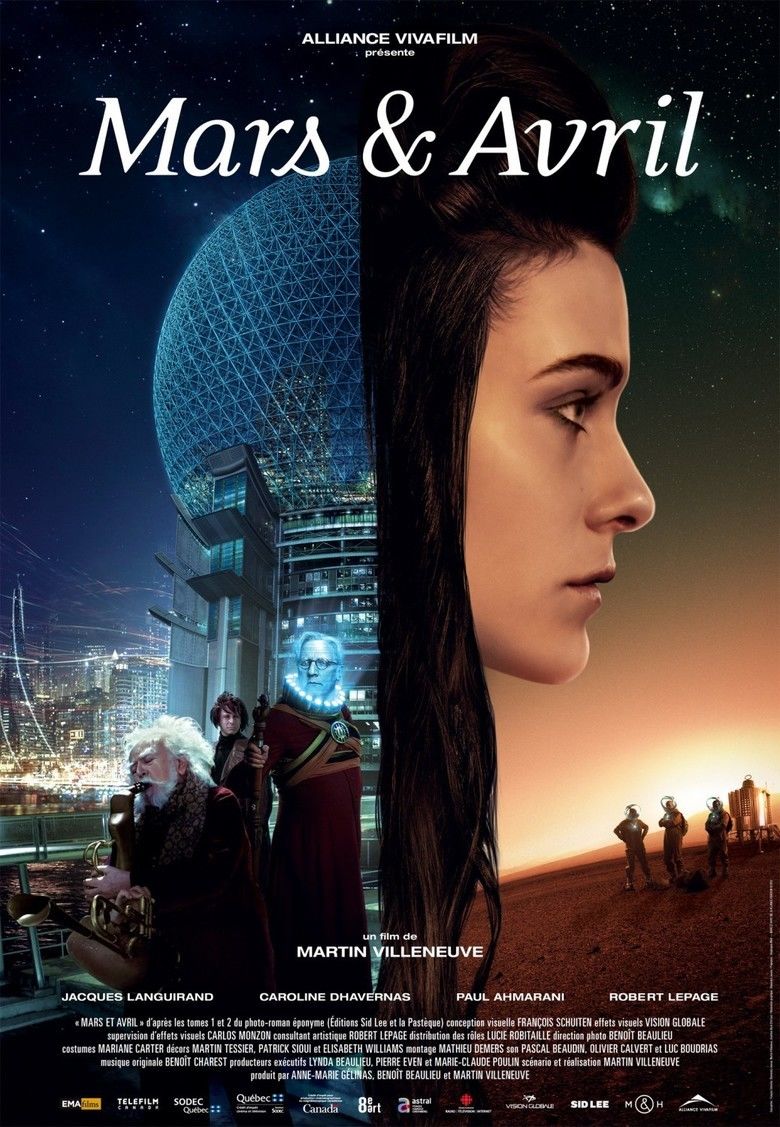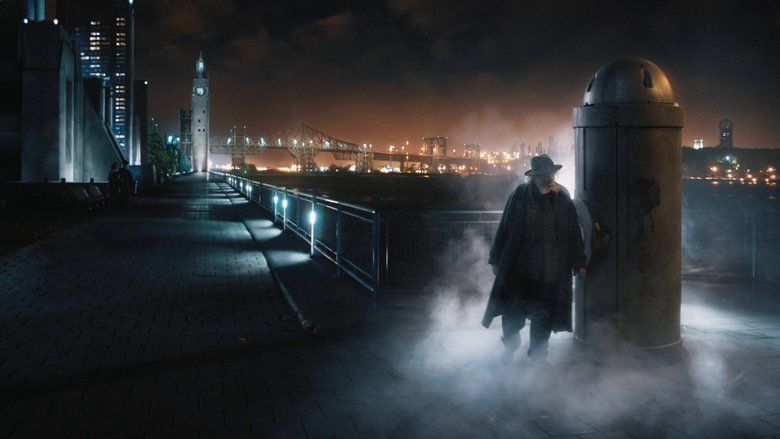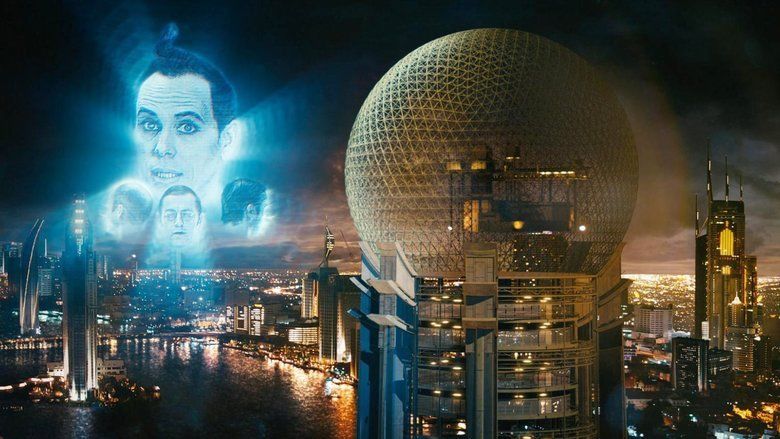Mars and April
6.2 /10 1 Votes
Director Martin Villeneuve Initial DVD release March 19, 2013 (Canada) Duration Country Canada | 6/10 IMDb Genre Drama, Sci-Fi Music director Benoit Charest Writer Martin Villeneuve | |||||||||||||||||||||||||||||||||
 | ||||||||||||||||||||||||||||||||||
Language French (English subtitled) Release date 2 July 2012 (2012-07-02) (Karlovy Vary International Film Festival) Based on Mars et Avril
by Martin Villeneuve Cast Jacques Languirand (Jacob Obus), Caroline Dhavernas (Avril), Paul Ahmarani (Arthur), Robert Lepage (Eugène Spaak - tête), Jean-Yves Asselin (Eugène Spaak - Body / Server PLC), Stéphane Demers (Bernard Brel)Similar movies Robert Lepage movies, Science fiction movies | ||||||||||||||||||||||||||||||||||
An elderly musician and his instrument maker become obsessed with the same woman.
Contents
- Releases
- Martin Villeneuves TED Talk
- Plot
- Cast
- Production design
- Production
- Other facts about the film
- Festivals
- References

Mars et Avril (aka Mars & Avril or Mars and April, � "Mars" here referring to planet Mars, and "Avril/April" to the lead female character) is a Canadian science fiction film starring Jacques Languirand, Caroline Dhavernas, Paul Ahmarani and Robert Lepage. The feature film, based on the graphic novels of the same name published by Sid Lee & la Pasteque, is written, produced and directed by Martin Villeneuve.

Shot on a very tight budget and with abundant use of green screen, Villeneuves feature film debut has a significant amount of visual effects. Belgian comic book artist Francois Schuiten (Les Cites Obscures) is the production designer, former ILM Senior Compositor Carlos Monzon (Avatar, Transformers, Star Trek) worked as VFX supervisor, and Oscar-nominated Benoit Charest (Les Triplettes de Belleville) composed the original score. The film was financed by Telefilm Canada, SODEC, Les Productions du 8e Art and the Harold Greenberg Fund, and is distributed in Canada by Alliance Vivafilm and in the United States by Gaiam. The official trailer on YouTube was released in Quebec theaters and on Alliance Vivafilms YouTube channel on December 21, 2011. The World premiere took place on July 2, 2012, at the 47th Karlovy Vary International Film Festival, Czech Republic (the film was selected in the section “Another View� for its unique artistic approach in both form and content). Since then, the film has been screened in many other major cinema events around the globe (see the FESTIVALS section below).

Set in a futuristic environment, "Mars et Avril" tells the story of an elderly musician and his instrument maker who both become obsessed with the same woman. She agrees to be the model for their next musical instrument but then gets lost in a virtual world on the way to Mars.
Releases
Mars et Avril got its theatrical release in Quebec on October 12, 2012, and reviews were generally positive. The film received four nominations at the 2013 Canadian Screen Awards: achievement in music, achievement in overall sound, best adapted screenplay and achievement in visual effects, and five nominations at the 2013 Jutra Awards.
The DVD of the film as well as the digital version on iTunes were released in Canada through Alliance Vivafilm on March 19, 2013, to critical acclaim, along with Benoit Charests original soundtrack and the trailer music composed by Ramachandra Borcar. On October 22, 2013, Benoit Charest won the Felix in the category Album of the year – original soundtrack at the ADISQ Gala. For the occasion, a limited edition of 300 vinyl records of the soundtrack was released, as a nod to the retro-futuristic look of the film.
In September 2013, Mars et Avril was sold to the U.S. and is now available on U.S. iTunes and on GaiamTV. The film is also available on iTunes in the UK, and all across Francophone Europe. Other major digital platforms will follow, starting in January 2014.
Martin Villeneuves TED Talk
On February 27, 2013, Martin Villeneuve gave a TED Talk about Mars et Avril at TED2013, thereby becoming the very first French Canadian speaker invited to this prestigious event that took place in Long Beach, California. Prior to his talk, the opening sequence of the film was shown, as well as a three minutes overview of the steps leading from the green screen to the final images. Martin Villeneuves talk, “How I made an impossible film,� was released on TED.com on June 7, 2013, and a month later was added to TEDs movie magic list, featuring famed directors such as James Cameron and J.J. Abrams. Since then, Mars et Avril is being referred to as the “Impossible Film�.
Plot
Adapted from two acclaimed graphic novels, Mars et Avril is set in a futuristic Montreal, where humanity is about to set foot on Mars. Jacob Obus (Jacques Languirand), a charismatic musician, takes pride in slowing down time by playing instruments inspired by women’s bodies, designed by his friend, Arthur (Paul Ahmarani). A love triangle develops when Jacob and Arthur both fall in love with Avril (Caroline Dhavernas), a young photographer. Enter Eugene Spaak (Robert Lepage), inventor, cosmologist and Arthur’s father, who unveils a new theory about man’s desire to reach Mars and helps Jacob find the true meaning of life and love.
Cast
Production design
Mars et Avril benefits from the collaboration of Belgian comic book artist Francois Schuiten, best known for drawing the series Les Cites Obscures published by Casterman, who worked on the film as production designer.
Martin Villeneuve’s influences came primarily from comic books, especially that of Francois Schuiten and his series Les Cites Obscures, whom he approached as production designer in 2007. He wanted the source of his inspiration to play a direct role in the creation of the film rather than try to mimic his style. In pre-production, Schuiten made some sketches of the sets and, in post-production, he oversaw the visual coherence of the whole film while acting as art direction consultant. Since the film was to be shot almost entirely on green screen, in only 25 days and on a very tight budget of 2.3 million CAD, the key to making it work laid in preparation. The 1200 shots were hand-drawn as storyboards and then edited with the dialogues in a detailed, two-hour-long animatic that mapped out every detail before shooting. Villeneuve went to Brussels in May 2008 to work with Schuiten, then Schuiten came to Montreal twice to follow up: in September 2008 and December 2011. Throughout filming and post-production, the two men touch-based as often as they could through Skype.
One of the main brainstorming sessions between Villeneuve and Schuiten is available as the audio commentary on the DVD of the film.
Production
In 2005, Robert Lepage optioned the rights to Martin Villeneuves Mars et Avril graphic novels (volumes 1 and 2) through his Quebec city-based motion picture company, Films Ex aequo (who had already produced The Far Side of the Moon in 2003), with the intent of adapting them into a science fiction feature film. While the author of the books was to write the script, Lepage was attached to the project as actor and producer.
A year later, Lepage shut down Films Ex aequo, deciding at the time that he would not direct any more films in Canada. Nevertheless, he strongly encouraged Mars et Avrils writer to take the directors chair. Martin Villeneuve took over the project, while Lepage remained involved as actor and creative producer.
In 2007, Villeneuve contacted the famous Belgian comic book artist Francois Schuiten (Les Cites Obscures), who accepted to work on the film as production designer. Schuiten had already worked on such films as Toto le Heros, The Golden Compass and Mr. Nobody. The young filmmaker was also able to convince Guy Laliberte, founder of Cirque du Soleil, to finance the creation of the imaginary musical instruments to be used by the actors on set. In 2008, SODEC, Telefilm Canada, The Harold Greenberg Fund and Alliance Vivafilm decided to finance the production. Due to the films significant amount of visual effects, an extensive year of pre-production was necessary. Also, in order to work around Robert Lepages extremely tight schedule, principal photography took place in Montreal in two segments; the first was in September 2008, and the second was in April 2009. Since Lepage only had a few days available for filming, Villeneuve turned his character into a hologram and had another actor wearing a green hood stand in for his scenes during principal photography. The film was almost entirely shot on green screen, in 25 days, using the RED digital camera.
Most of the actors who appeared in the graphic novels reprised their roles in the film, with the exception of Marie-Josee Croze (who portrayed the lead female character in the books), due to a schedule conflict. Caroline Dhavernas (Passchendaele, Wonderfalls) was then hired to play the part of AVRIL, opposite Jacques Languirand (JACOB OBUS), Robert Lepage (EUGENE SPAAK) and Paul Ahmarani (ARTHUR SPAAK). From the original cast of the books, Stephane Demers also reprised the role of BERNARD BREL.
Robert Lepage plays a cosmologist whose research into virtual technologies extends to bold experiments on himself. His head is actually a hologram, with all of his ideas, memories and thoughts stored electronically. Six cameras were trained on Lepages head while another actor portrayed the cosmologists body.
By the end of 2009, the editing of a first cut was assembled. In 2010, Martin Villeneuve searched for new investments in order to complete the 550 VFX shots involved in the film. In early 2011, Anne-Marie Gelinas and Benoit Beaulieu joined Villeneuve as producers. Telefilm Canada and Alliance Vivafilm both accepted to raise their initial investment, and so did Robert Lepage and Lynda Beaulieu though their new Quebec city-based motion picture company, Les Productions du 8e Art. At this point, Pierre Even (C.R.A.Z.Y.) and Marie-Claude Poulin from Item 7 also joined the team as executive producers.
In March 2011, a re-shoot took place at Lepages request. An additional scene involving Languirand and Dhavernas was shot, and the final cut of the film was completed during the summer of the same year. Montreal-based post-production company Vision Globale (under the supervision of former ILM Senior Compositor Carlos Monzon) then started the visual effects and sound design. Also, Oscar-nominated Benoit Charest (Les Triplettes de Belleville) was tasked with scoring the music.
The official trailer was released in Quebec theaters and on Alliance Vivafilms YouTube channel on December 21, 2011. The official poster, designed by Francois Schuiten, was revealed online on March 11, 2012, once the film was entirely completed. The World premiere took place on July 2, 2012, at the 47th Karlovy Vary International Film Festival, Czech Republic (the film was selected in the section “Another View� for its unique artistic approach in both form and content). The movie was well received by the public and the reviews were positive. The first in a series of production videos on YouTube unveiling the films creation has been released online on August 16, 2012, along with the official website created by the Sid Lee agency. A 22-minute “Making Of� was aired on ARTV in October 2012 in order to promote the release of the film, and is now available in French on YouTube and with English subtitles on YouTube.
Mars et Avril was released in Quebec on October 12, 2012 and reviews were generally positive.
Other facts about the film
Festivals
References
Mars and April WikipediaMars and April IMDb Mars and April themoviedb.org
